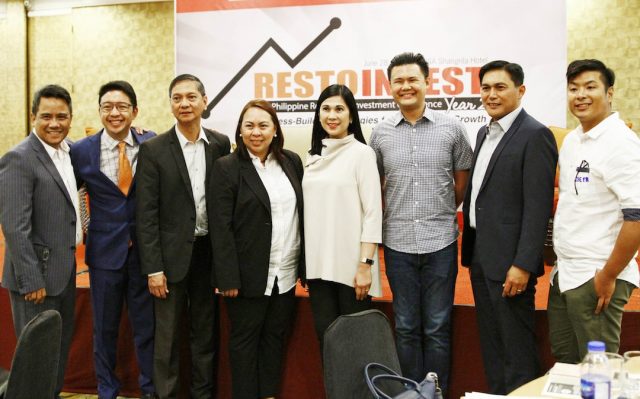
The country’s food and beverage industry is certainly bullish with international food events such as Madrid Fusion Manila and the World Street Food congress; food parks sprouting around the metro; and Filipino cuisine getting positive comments by renowned culinary authorities like Anthony Bourdain, Nigella Lawson, and Gordon Ramsay, to name a few.
In line with these developments, food service management consulting firm Courage Asia once again gathered respected names in the food and beverage industry to give vital insights at the Philippine Restaurant Investment Conference held on June 28 at EDSA Shangri-La in Mandaluyong City
The whole-day conference shed light on various topics, some of which included current food trends, branding, and the critical role of digital technology in growing your food business.
Courage Asia’s President Adolf Aran Jr. shared, “This conference is meant to keep track of what’s happening, the developments taking place in the industry. We gathered some experts to provide different perspectives—from the government, mall operators, and from the players themselves both big and small.”

To kick off the whole-day conference, Department of Trade and Industry Assistant Secretary Art Boncato delivered a speech underscoring that now is the best time to be in a restaurant business. He noted: “There’s no better time to be in the restaurant industry and promoting Philippine cuisine than today.
“Philippines’ growth outlook remains positive. The World Bank projects that the real GDP will grow at the rate of 6.9% in 2017 and 2018 as Philippines expects to remain as one of the best performers in East Asia in terms of economy.”
The assistant secretary also highlighted the government’s efforts to encourage entrepreneurship—including food businesses—to flourish and grow.
“Our goal is to develop innovation-driven, infrastructure-enabled, import-export competitive, and inclusive Philippine industries characterized by deep participation of Micro, Small and Medium Enterprises (MSMEs) in the regional and global production networks and global value chain,” Boncato said.

Some of the government’s efforts in easing the doing of business include the further reduction of time, steps, documents, and signatories needed to be secured in filing business permits and licenses; improving our world standing in the Doing Business report; streamlining policies, which burden businesses; promoting competitiveness at the local level; and making business easier for MSMEs by building 500 negosyo centers that help MSMEs start business.
Acknowledging the growing digital economy, the DTI assistant secretary also mentioned that the department has rolled out the Philippine E-commerce Roadmap, which aims to solidify the country’s position in terms of domestic and cross border e-commerce and seamless connectivity.
Boncato was joined by other speakers from different backgrounds including fast-food, fast casual, casual dining, fine dining, commissaries, to hotel-based restaurants, and more.
Here are some of insights shared by the speakers at the conference:
1. Branding is key to success.
Eileen Borromeo, Strategic Planning head of McCann Group underscores the importance of branding to be able to stand out in a competitive restaurant business.
“Branding is beyond iconography, or stylishly designed collaterals, although these are also important.. Branding helps create emotional head space that makes us prefer one over the other regardless of whether we offer the same things or not,” she noted.
According to Borromeo, when you have a clear brand strategy that brings your brand to life, you’re actually in a better position to deliver growth and weather challenges.
To achieve this, she suggested five tips: 1. Know your customers intimately; 2. Highlight what’s unique in your restaurant; 3. Keep up with the times by not riding on the latest trend but by staying relevant to your diners and to this industry; 4. Make the experience of your diners consistent; and 5 Unite with your vision.
2. Malls have a growing appetite for restaurants.
Regardless of large format restaurants or small concept ones, malls now want more food tenants.
“For us it’s an important part of our tenant mix. Our consumers who come in millions every day, if they’re not going to shop for retail, they’re going to shop for food–a beverage, a snack, or a meal,” Regina Katigbak, AVP of SM Malls shared.
“Before, our average number of tenants for food was toughly about 15% to 20% and is primarily fast food. Now we are at least 30% of our tenant mix is dedicated to food,” she added.
Katigbak also shared that SM is dedicated in developing more local brands, and bringing in new concepts, as well as regional fares.
“People come to the mall to sample more flavors and tastes. With this new format, the food culture is really going big. Food courts are no longer as it used to be before. It’s now a different playing field,” she said.
“We want to work with local food players..We have global firsts that opened with us but we’re also looking into championing more of the regional gems,” she added.
3. Your food must tell a story.
“People just don’t like to eat your food. People like to eat the story behind your food,” noted RJ Ledesma, co-founder of Mercato Centrale, book author, and motivational speaker.

On that note, it is relevant to ask questions like, “What is the heritage behind your food?” “What is the story?” “What is the hugot behind your food?”
“Be creative in telling the story behind your food,” Ledesma advised,and noted that in relation to this, heritage food will stay longer as a trend.
“There is a big opportunity in bringing regional heritage cuisines in the mainstream,” he said.
Along with this trend, Ledesma also gave the following tips: stick to a trend and not on a fad; have a hero signature dish that people will talk about; always have a chicken dish that will keep you afloat since Filipinos like to eat chicken; and be active in social media.
4. Be entertaining on social media.
Noting that his business grew via social media, Ledesma gave some tips on how to effectively and entertainingly engage followers on various digital platforms.
“Be entertaining nowadays because apparently, this is what will make you viral..Making it interesting, make it funny, so that people would want to look at your post, “he said.
In posting content, Ledesma noted that consistency is better than frequency, and that people would always want to watch an interesting video.
“Don’t post so much pictures every day but on a specific time of the day or a specific periods. Always post because people will look forward to it,” he shared.
“Video is greater than picture; picture is greater than text. Nowadays, no one will read the text; people will really look on a video. Do something people might want to watch. The more dynamic the post, the better. Make it mouth watering to watch,” he added.
Encouraging interaction and building a community online can also yield positive results to your business.
“The more that we are able to build a community online, the more people interact with us..They like the idea that they were able to built a certain rapport with the market,” Ledesma said.
4. Your business is more than the food you offer.
“There is a need to expand the definition of the word ‘product,’ and extend ourselves from the actual consumable merchandise,” noted Pinky Yee, president of Domino’s Pizza Philippines Express.

In her talk on the future of fast food, she shared that consumers are also looking for the most seamless, most accessible, most straightforward, and quickest way to get outstanding food.
To cater to these needs, Yee said that Domino’s Pizza uses innovative digital technology to stay relevant in the industry and provide the best service to their customers.
“We consistently aligned our use of technology for the sole purpose of uplifting customer experience and to allow them to engage with our brand in an interactive way across digital platforms,” Yee said, and shared the digital innovations they are utilizing including their Pizza Tracker.
“Ultimately, by using technology, in a way that enables personal involvement, efficiency, and convenience, you create engagement. In the case of Domino’s, thinking like a technology company allows us to become a progressive, digital first brand in the eyes of our customers. In fact, our passion to deliver an amazing customer experience through innovative technology became so apparent that now, Domino’s is considered as ‘a digital company that sells pizza’,” she added.
5. Have a positive paranoia.
Recognizing that the food and restaurant business is a ‘hypercompetitive’ industry, having a ‘positive paranoia’ and constant innovation can enable your brand to withstand challenges. This is according to Vic Gregorio, VP of Shakey’s Philippines, who gave tips on how one’s food business can stand out in a highly competitive environment.

“In Shakey’s, we always know that we’re in a hypercompetitive environment. We know that it will get tough. We always have this positive paranoia. We always have that insecurity that we’re not doing enough; that we can do more that it will get tougher. Cost will go up; competition [and] pressure will just increase. We need to do more and more… but as long as we stay committed to our philosophy in ‘wow-ing’ the guest, we believe we have a good chance in staying ahead of the game,” he shared.
As part of their belief in prioritizing their guests, Gregorio also underscored the importance of simultaneously innovation in their brand.
“One of the reasons people go to a place is because they want to try something new. We try to come up with innovative products that have never been done before. Not just a product, but something that would stand out,” he said, noting that one of their newest offering, the Scallop Primo Pizza is a first in the market.
“We always prioritize our guests. We believe that by doing so, the end product will be patronage, sales, and profit,” he also said, and added that they come up with compelling value proposition, including an environment that’s comfortable and conducive.
• InterAksyon Lifestyle is a proud media partner of RestoInvest2. For more restaurant business tips and ideas, check Dine Philippines’ website.









